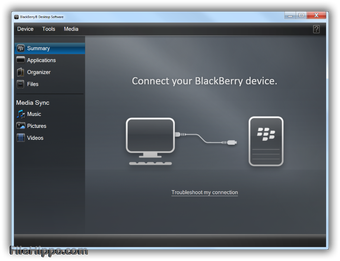Enhanced connectivity: BlackBerry Desktop Software
Screenshots
The BlackBerry Desktop Software serves as a pivotal tool for syncing data between a user's PC and their BlackBerry smartphone or tablet. It introduces a host of functionalities tailored to streamline connectivity and data management.
BlackBerry Desktop Software explained in detail
BlackBerry Desktop Software is a utility program developed by BlackBerry Limited, designed to facilitate the synchronization, management, and connectivity between BlackBerry smartphones or tablets and a user's personal computer. It provides a platform for users to sync various data, including contacts, calendar appointments, tasks, and notes, between their BlackBerry devices and applications on their Windows-based PCs.
Key features of BlackBerry Desktop Software include:
- Data synchronization: It allows seamless syncing of contacts, calendar events, tasks, and notes with Windows applications like Microsoft Outlook, Windows Calendar, IBM Lotus Notes, and Yahoo!.
- Backup and restore: Users can back up and restore data manually or automatically between BlackBerry devices, enabling efficient data management and security.
- App management: The software facilitates the addition or removal of apps on BlackBerry devices, allowing users to manage their software ecosystem.
- Media sync: It simplifies the process of syncing iTunes playlists and Windows Media files, making it easy to transfer music, videos, and photos between the PC and the BlackBerry device.
- Device migration: A device switch wizard feature assists in migrating data, including photos, videos, and albums, from one BlackBerry device to another.
Does BlackBerry Desktop Software still work?
It's essential to note that BlackBerry has announced the discontinuation of updates and technical support for the BlackBerry Desktop Software. As a result, there won't be any further updates, including security patches, and technical support will no longer be available. This aspect raises concerns about the ongoing security and usability of the software for users in the future.
BlackBerry Desktop Software alternatives to try
For BlackBerry users seeking alternatives to the BlackBerry Desktop Software, considering the software's discontinued support, here are some options that might be useful:
- BlackBerry Link: This was a successor to BlackBerry Desktop Software specifically designed for BlackBerry 10 devices. It facilitated data syncing, backup, and media management. However, like BlackBerry Desktop Software, it might not receive further updates or support.
- Third-party cloud services: Platforms like Google Drive, Dropbox, or Microsoft OneDrive can serve as alternatives for storing and syncing certain types of data across devices, including BlackBerry devices, although they might not offer the same comprehensive device management features.
- Built-in device syncing: BlackBerry devices often have built-in features for syncing contacts, calendar events, and emails with various accounts like Google, Microsoft Exchange, or other email providers. These can serve as alternatives for specific data syncing needs.
Depending on the specific model of BlackBerry device being used, BlackBerry might have specific software or tools available for managing that device. Exploring the official BlackBerry support pages or forums could yield information about device-specific software alternatives.
Given the discontinuation of support for BlackBerry Desktop Software, finding a perfect alternative might be challenging. Users may need to combine different tools and services to achieve a similar level of functionality and data management previously offered by BlackBerry's official software.
Should you download BlackBerry Desktop Software?
BlackBerry Desktop Software, despite its impending lack of updates and support from BlackBerry, remains a powerful tool for users seeking efficient connectivity and data management between their PCs and BlackBerry devices.
Its user-friendly interface and diverse synchronization capabilities have been pivotal in enhancing user experiences. However, with the discontinuation of support, users may need to consider alternative solutions for long-term security and usability.


